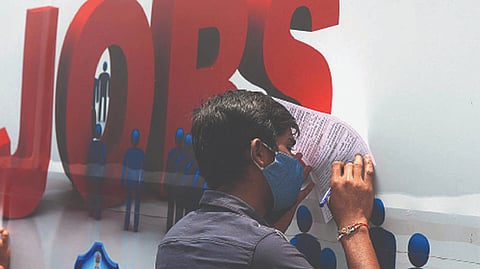

By Ashoka Mody
NEW DELHI: Indian elites are giddy about their country’s economic prospects, and that optimism is mirrored abroad. The International Monetary Fund forecasts that India’s GDP will increase by 6.1% this year and 6.8% next year, making it one of the world’s fastest-growing economies. Other international commentators have offered even more effusive forecasts, declaring the arrival of an Indian decade or even an Indian century.
In fact, India is barrelling down a perilous path. All the cheerleading is based on a disingenuous numbers game. More so than other economies, India’s yo-yoed in the three calendar years from 2020 to 2022, falling sharply twice with the emergence of COVID-19 and then bouncing back to pre-pandemic levels. Its annualized growth rate over these three years was a feeble 3.5%, about the same as in the year immediately preceding the COVID crisis.
All forecasts of higher future growth rates are extrapolating from the latest pandemic rebound. Yet, even with pandemic-related constraints largely in the rearview mirror, the economy slowed in the second half of 2022, and that weakness has persisted this year. Describing India as a booming economy is wishful thinking clothed in bad economics.
Worse, the hype is masking a problem that has grown over the 75 years since independence: anaemic job creation. Over the next decade, India will need 200 million more jobs, on net, to employ those who are of working age and seeking work. But this challenge is virtually insurmountable, considering that the economy failed to add any net new jobs over the past decade, when 7-9 million additional jobseekers were entering the market each year.
This demographic pressure often boils over, fuelling protests and episodic violence. In 2019, 12.5 million people applied for 35,000 job openings in the Indian railways: a job promised for every 357 people who sought one. In January 2022, the railway authorities announced that they were not ready to make the job offers. The applicants went on the rampage, burning train cars and vandalising railway stations.
With urban jobs scarce, tens of millions of workers returned during the pandemic to eking out meagre livelihoods in agriculture, and there many have remained. India’s already distressed agriculture sector now employs 45% of the country’s workforce. Farming families suffer from stubbornly high underemployment, with many members sharing limited work on plots rendered steadily smaller through generational subdivision. The epidemic of farmer suicides persists. To those anxiously seeking support from rural employment-guarantee programs, the government unconscionably delays wage payments, triggering recurrent protests.
For far too many Indians, the economy is broken. The problem lies in the country’s small and uncompetitive manufacturing sector. Since the liberalising reforms of the mid-1980s, the manufacturing sector’s share of GDP has fallen slightly, to about 14%, compared to 27% in China and 25% and rising in Vietnam. India commands less than a 2% global share of manufactured exports, and as its economy slowed in the second half of 2022, the manufacturing sector contracted further.
Yet it is through exports of labour-intensive manufactured products that Taiwan, South Korea, China, and now Vietnam came to employ vast numbers of their people. India, with its 1.4 billion people, exports about the same value of manufactured goods as Vietnam does with 100 million people – and Vietnam is poised to race ahead.
Those who believe that India stands at the cusp of greatness usually focus on two recent developments. First, Apple contractors have made initial investments to assemble high-end iPhones in India, leading to speculation that a broader move away from China by manufacturers will benefit India, despite the country’s considerable quality-control and logistical problems. While such an outcome is of course possible, academic analysis and media reports are discouraging. Economist Gordon H Hanson anticipates that Chinese manufacturers will move labour-intensive manufacturing from the country’s expensive coastal hubs to its less-developed interior, where production costs are lower.
Moreover, investors moving out of China have gone mainly to Vietnam and other countries in Southeast Asia, which (along with China) are members of the Regional Comprehensive Economic Partnership. India has eschewed membership in this preferential trade bloc, because its manufacturers fear that they will be unable to compete once the other member states gain easier access to the Indian market.
As for US producers pulling away from China, most are “near-shoring” their operations to Mexico and Central America. Altogether, while some investment from this churn could flow to India, the fact remains that inward foreign investment fell year on year in 2022.
The second source of hope is the Indian government’s Production-Linked Incentive Schemes, which were introduced in early 2021 to offer financial rewards for production and jobs in sectors deemed to be of strategic value. Unfortunately, as former Reserve Bank of India Governor Raghuram G Rajan and his co-authors warn, these schemes, like previous sops to manufacturers, are likely to end up merely fattening corporate profits.
India’s heroic run with start-up unicorns is also fading. The sector’s recent boom relied on cheap funding and a surge of online purchases by a small number of customers during the pandemic. But most start-ups have dim prospects for achieving profitability in the foreseeable future. Purchases by the small customer base have slowed, and funds are drying up – even for firms like edtech giant Byju.
Looking past the illusion created by India’s rebound from its COVID depths, the country’s economic prognosis appears bleak.
Visit news.dtnext.in to explore our interactive epaper!
Download the DT Next app for more exciting features!
Click here for iOS
Click here for Android